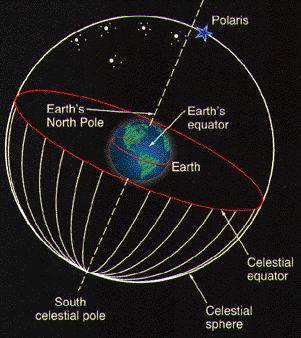
Astronomy 105 Homework #1
Due February 1st, 2008
Name:___________________________________________The celestial equator is the projection of the Earth's equator (latitude = 0o) onto the celestial sphere (see page 41). It divides the sky in to two regions: northern and southern hemispheres. The angular distance from the celestial equator to the north celestial pole (to Polaris, the pole star) is 90o. This set-up is shown in the drawing below.

1) Can someone at the South Pole (or anywhere in the southern hemisphere) see Polaris? (2 pts)
2) What is the elevation angle of Polaris if you a) lived on the equator, b) lived at the north pole,
and c) lived at a latitude of 45o north. (6 pts)
The zenith is the point in the sky straight overhead, that is the point in the sky that always has an elevation angle of 90o. The angle between the zenith and the celestial equator is exactly equal to your latitude. So the elevation of the celestial equator on the meridian is simply 90o - Latitude.
3) We live in Las Cruces, with a latitude of 32.5o. What is the elevation angle of the celestial
equator at the meridian? (5 pts)
4) There are 360 degrees in a circle, and in Longitude. Since the
Earth rotates once in 24 hours (our day), every hour the Earth rotates 15o. The longitude of Las Cruces is 106.7o, where 0o
is defined to be Greenwich (near London) England. How many hours
difference are there between Las Cruces and Greenwich? (5 pts)
5) The longitude of New York City is 71.9o, how many hours (round your numbers) are there between New York City and Las Cruces?
Thus,
when it is 4pm EST in New York City it is ____________ MST in Las Cruces. (7pts)